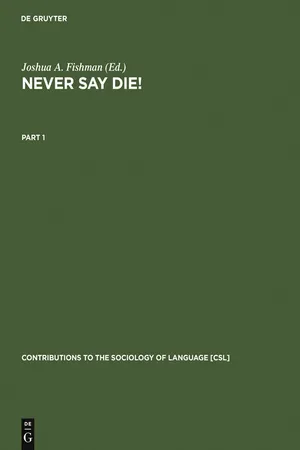
This is a test
- 779 pages
- English
- PDF
- Available on iOS & Android
eBook - PDF
Never Say Die!
Book details
Table of contents
Citations
Frequently asked questions
At the moment all of our mobile-responsive ePub books are available to download via the app. Most of our PDFs are also available to download and we're working on making the final remaining ones downloadable now. Learn more here.
Both plans give you full access to the library and all of Perlego’s features. The only differences are the price and subscription period: With the annual plan you’ll save around 30% compared to 12 months on the monthly plan.
We are an online textbook subscription service, where you can get access to an entire online library for less than the price of a single book per month. With over 1 million books across 1000+ topics, we’ve got you covered! Learn more here.
Look out for the read-aloud symbol on your next book to see if you can listen to it. The read-aloud tool reads text aloud for you, highlighting the text as it is being read. You can pause it, speed it up and slow it down. Learn more here.
Yes, you can access Never Say Die! by Joshua A. Fishman, Joshua A. Fishman in PDF and/or ePUB format, as well as other popular books in Languages & Linguistics & Linguistics. We have over one million books available in our catalogue for you to explore.
Information
Table of contents
- Preface
- The Sociology of Yiddish: A Foreword
- PART I SOCIOHISTORICAL PERSPECTIVE
- The Reality of Jewishness versus the Ghetto Myth: The Sociolinguistic Roots of Yiddish
- The Yiddish Language: Its Cultural Impact
- Vegn der natsyonaler role fun yidish un der yidisher kultur [Concerning the Ethnohistorical Role of Yiddish and Yiddish Culture]
- Ume veloshn: yidish folk, yidish loshn [People and Language: Jewish Nationality and Yiddish Language]
- PART II ORTHODOXY: THEN AND NOW
- A Defense of Yiddish in Old Yiddish Literature
- Yidishkeyt un yidish [Jewishness and Yiddish]
- Di rekht fun ‘loshn ashkenaz’ bay dintoyres [The Rights of Yiddish in Suits in Rabbinic Courts] / Der vilner goen un yidish [The Sage of Vilna and Yiddish]
- Geule fun loshn [Redemption of Language]
- The Role of Yiddish in American Ultra-Orthodox and Hassadic Communities
- Who Needs Yiddish?
- Sounds of Modern Orthodoxy: The Language of Talmud Studies
- PART III MODERNIZATION MOVEMENTS AND MODERN ATTITUDES
- Di fir klasn [The Four Categories]
- Matesyohu mizes un di polemik vegn yidish [Matesyohu Mizes (Mattathias Mieses) and the Polemic about Yiddish]
- Zhitlovsky and American Jewry
- Mir bashuldikn un monen akhrayes! [We Accuse and Demand Responsibility!]
- Der blik az yidish iz der tamtsis fun yidishkayt – di sakone fun der formule ‘lingvistish-sekularistish’ [The View that Yiddish is the Quintessence of Jewishness – The Danger of the Formulation ‘Linguistic-Secularistic’]
- An ofener briv tsu undzer yidishistisher inteligents [An Open Letter to Our Yiddishist Intelligentsia]
- Who Needs Yiddish? A Study in Language and Ethics
- PART IV HISTORIC MOMENTS
- Attracting a Following to High-Culture Functions for a Language of Everyday Life: The Role of the Tshernovits Language Conference in the ‘Rise of Yiddish’
- Di yidishe shprakh af der tog-ordenung fun der sholem-konferents in pariz, 1919 [The Yiddish Language on the Agenda of the Peace Conference in Paris, 1919]
- Tsu der efenung fun der yidish-katedre in yerushelayemer universitet [On the Inauguration of the Yiddish Chair at the University in Jerusalem]
- Address at the Dedication of the Leivick House in Israel, May 14, 1970
- Deklaratsye fun der velt-konferents far yidish un yidisher kultur in yerushelayem...dem 23stn–26stn oygust 1976 [Declaration of the World Conference for Yiddish and Yiddish Culture in Jerusalem... August 23–26, 1976]
- PART V FORMAL INSTITUTIONS OF LANGUAGE: THE PRESS, LITERATURE, THEATER, SCHOOLS
- Der ‘bund’ un der gedank vegn a yidish-veltlekher shul [The ‘Bund’ and the Idea of a Yiddish-Secular School]
- Tsvey shprakhn–eyneyntsike literatur [Two Languages – One Literature]
- Lererkursn far yidish in lodzher geto [Yiddish Courses for Teachers in the (Nazi) Ghetto of Lodz]
- The Night of the Murdered Poets
- An Educational Assessment of the Yiddish Secular School Movements in the United States
- The American Yiddish Press at Its Centennial
- Ida Kaminska and the Yiddish Theater
- Yiddish in the University
- PART VI MAINTENANCE AND SHIFT
- Di yidishe shprakh in undzer privat-lebn [The Yiddish Language in Our Private Life]
- The Struggle for Yiddish During World War I: The Attitude of German Jewry
- Di shprakhn bay yidn in umophengikn poyln [The Languages of Jews in Independent Poland]
- Lebediker untergang [Lively Death]/A loshn af tomid, nisht af dervayl [A Language for Always, Not Just for a While]
- Yiddish in Melbourne
- Knowledge, Use, and Evaluation of Yiddish and Hebrew among American Jewish College Students
- PART VII SOCIOLINGUISTIC VARIATION AND PLANNING
- Vegn zhargon oysleygn [About Spelling Zhargon ( = Yiddish)]
- Undzer mame-loshn [Our Mother Tongue]
- Vegn litvishn dialekt in kongres-poyln [Concerning the Litvak (= Northeastern) Dialect in Congress Poland] Note Berliner Zeyer gerekht [Absolutely Right]
- The ‘Hidden Standard’: A Study of Competing Influences in Standardization
- Politics and Linguistics in the Standardization of Soviet Yiddish
- Some Aspects of the Use of Pronouns of Address in Yiddish
- Bilingualism and Dialect Mixture Among Lubavitcher Hasidic Children
- Epilogue: Contributions of the Sociology of Yiddish to the General Sociology of Language
- Original Sources
- Index